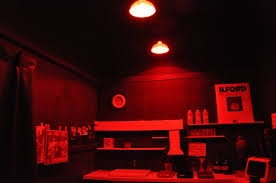“The Substance” is all isolation. It drags viewers through endless hallways and cavernous rooms; past hypnotizing neon, fluorescent lights; down back roads and shady sidewalks not taken, where the protagonist, Elisabeth Sparkle, seems to exist alone. The film supposedly transpires in Hollywood, but it’s hard to make out any of its distinguishing features against an amalgam of palm trees and unremarkable buildings. Sparkle’s enormous L.A. apartment consists of sparsely furnished rooms, and the grand window in the foyer overlooks a sea of nothing. Her only notable decoration? A life-size portrait of herself in a blue leotard, airbrushed and photoshopped to oblivion, and a couple of years younger — a reminder of better days.
“The Substance’s” relentless solitude is intentional. “It was something I was obsessed [with], that every location has some kind of unrealistic vibe that you can’t really [pin down],” director Coralie Fargeat told AnOther Magazine. Life through Sparkle’s eyes is disorienting from beginning to end, disconnected from reality and any sense of identity. Like her empty apartment, it’s a vacuous space filled and vacated by others — unsurprising for an egotistical celebrity with a star on the Hollywood Walk of Fame. But when that stardom inevitably ends, how do you fill the void?
In “The Substance,” we follow 50-year-old Sparkle, played by Demi Moore, from the peak of her fame to its tactless end. Once the host of a daytime aerobics show, she’s abruptly thrust out of work by a sleazy network executive for being too old to appeal to audiences. “People always ask for something new,” he chides. “At fifty, well, ‘it’ stops.” “It” being, of course, an expiration date on female celebrity, like a carton of spoiled milk. Distraught and desperate for a second chance, Sparkle turns to a black market drug to make herself young again: the Substance, a lurid, slime-green concoction that promotes total cell restoration and duplication. After her graphic transformation, Sue, a younger, “better” version of herself, is born. She’s quickly hired as the show’s new lead, all public memory of Sparkle is lost and the world keeps spinning, down another woman who’s aged out of her right to participate. The only catch is that Sue and Elizabeth must switch places every week, a feat which becomes unmanageable as Sparkle descends further into self-hatred.
“The Substance” holds nothing back when constructing Sparkle’s world. Everything is “turned up to 11,” as NPR said; not a scene goes by without some degree of repulsiveness, from Sparkle’s gory bearing of Sue out of her spine to her depressively staring at herself in the mirror, aged and horrified by what time has done to her. The film almost manages to convince viewers that 62-year-old Demi Moore is indeed ugly — the fault of her character’s twisted worldview, relentlessly fixated on any whisper of imperfection. You wonder why such a beautiful woman would despise herself so much, but then you recall that she’s working for men like her boss, eager to throw her to the wolves when audiences no longer want her. “[The film] has no [subtlety] and doesn’t particularly want any,” The New York Times noted. “Elisabeth is still gorgeous by any sane person’s reckoning, but surrounded constantly by a version of herself with a little more collagen, she is being slowly driven mad.”
Fargeat leverages this delusion to expose its creator, later revealed as the film’s true villain: the male gaze. Sue is everything an audience could want — young, slender and well-endowed in all the right places. The camera holds nothing back in eating her alive. “[It] openly ogles [actress Margaret] Qualley’s body, running slowly up and down her frame, clad and lit in a sharp, shiny way,” said the New York Times. “It goes on forever, and it’s uncomfortable, and that is obviously the point.” With body shot after body shot, Sue is sliced up into easily digestible pieces for the viewer, which quickly goes from enticing to stomach-churning as it’s drawn out for minutes on end. The focus on her personhood is lost, and she becomes a mess of parts — the cycle that turned Sparkle into the obsessed self-loather she is. In this way, Fargeat wrenches the audience under the interrogation light, hanging the responsibility around the necks of those compelled by the male gaze to objectify her. The message rings loud and clear: We should feel ashamed for allowing this system to stand. It destroys women, and when examined, it disgusts us.
But this revelation never affords Sparkle a break; the damage is already done, and as her younger counterpart climbs the ladder of fame, she spirals deeper into abhorrence. During her turns with their shared consciousness, she can only binge-eat and watch clips of Sue on the television, waiting impatiently for her existence to end and Sue’s to begin. Even when a friend from elementary school asks her out on a date, awarding her an opportunity to enjoy life as herself, she can’t leave her sterile, gloriously capacious apartment and let the world see her ravaged by time. So, she begins misusing the Substance — first refusing to switch bodies for a few hours, then for days on end — until she withers away. “Sue drains Elizabeth’s body to dregs,” said The Cut, “stopping only when … she’s forced to switch places or, it’s implied, die.” Keeping Sue alive siphons the vitality out of Sparkle until looking back on a past when she was beloved, back on her younger self, is the only way she can live. It’s a metaphorical death that manifests into reality when Sparkle and Sue fight for dominance as their fairytale comes crashing down, culminating in an explosive, disgusting finale where the Substance destroys their bodies. Nothing lasts forever, of course, and at the punishing hand of Hollywood, Sparkle loses more than her place in the limelight. She loses everything.
“The Substance” has opened to mass critical acclaim; it maintains a 90% on Rotten Tomatoes, was awarded Best Screenplay at the Cannes Film Festival and is now the highest-grossing film distributed by Mubi. The Santa Monica Mirror calls it “one of 2024’s best films, both a cinematic dream and nightmare,” with NDTV adding that it’s “stupefyingly sobering.” Fargeat takes masterful care in building up and knocking down Sparkle like fame does its female stars, pulling no punches in vividly depicting how women are wrung dry to serve an audience. Then, as they combust, the world sits back and watches as paparazzi snap pictures and tabloids call them crazy, like their breakdown is a tragic coincidence. But coincidences can’t happen twice, and it’s a carefully oiled machine that keeps manufacturing them. Lest we want Elisabeth Sparkle’s fate to continue playing out in the real world, we must throw a wrench in the gears.
“The Substance” is available in theaters and streaming on Amazon Prime Video.










































